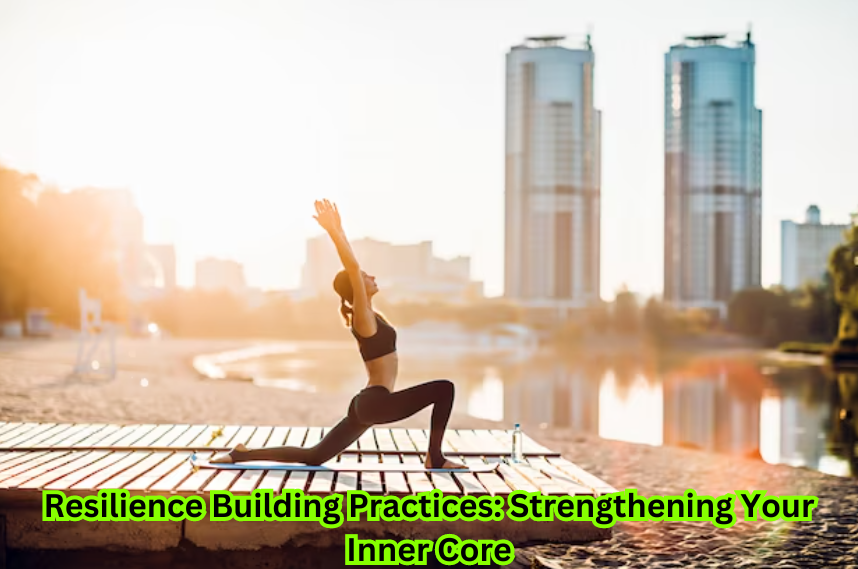When problems come up in life, being resilient is the key to not only living but also growing. This begins a deep dive into “Resilience Building Practices: Strengthening Your Inner Core.” This guide will show you practical and important things you can do to strengthen your inner power. Let us go on an empowering trip that will give you the tools to overcome hard times and come out better than ever.
How to Understand Resilience
The Heart of Being Resilient H1: Getting Through Life’s Storms
Being resilient means getting back on your feet after a loss, dealing with change, and weathering life’s storms with grit and style. Avoiding problems is not the point; the point is to build inner power that lets you face problems head-on.
A Process That Changes
Resilience is a process that changes over time as we go through new things. It means changing the way you think to see problems as chances to learn and fail and lose as steps toward becoming stronger.
Practices for Building Resilience
Developing a Mindset for Resilience: Being open to a growth mindset
A growth attitude means seeing problems as chances to learn and improve. Believe in your ability to change and adapt, and do not see losses as failures but as learning opportunities.
Positive Talk to Yourself
How we talk to ourselves is important. Talk positively to yourself and stop criticizing yourself. Instead, be kind to yourself. Positive affirmations and mental conversations are big parts of becoming more resilient.
Getting stronger emotionally
How to Recognize and Handle Your Emotions
Emotional strength means being able to recognize and control your feelings. Know that it is okay to have a lot of different feelings. The important thing is to be aware of them and act with care.

Creating Ways to Deal With Stress
Find good ways to deal with stress that work for you. Having a variety of ways to deal with stress makes you more emotionally strong. This includes practicing mindfulness, writing in a journal, and asking for help from friends and family.
Making social connections stronger
Making a Helpful Network
When things get tough, having strong social ties can help. Build strong ties with people who will back you, and do not be afraid to ask for help when you need it.
Giving and getting help
Being resilient takes work from everyone. Be willing to help others because it makes you feel connected and gives you a sense of meaning. In the same way, do not be afraid to ask for help when you need it.
Being physically healthy and strong
The Link Between Mind and Body
Having good physical health is a big part of having strong mental health. Make it a priority to exercise regularly, eat well, and get enough sleep. A strong mind works best with a healthy body.
Steps to Take to Lower Your Stress
Add techniques that help you deal with stress to your daily life. Whether you do yoga, deep breathing, or meditation, these activities help you deal with stress better and make you stronger overall.
Getting Past Common Problems
Seeing setbacks as chances to grow: How to Learn from Mistakes
To be resilient, you must see setbacks as chances to learn and grow. Please do not dwell on failures; think about them, learn from them, and use what you have learned to power your progress.
Keeping your optimism up
One important part of being resilient is staying positive when bad things happen. Focusing on what you can control and looking for the good in bad scenarios will help you keep a positive attitude.
Building up long-term resilience
Setting up resilience as a way of life: Keep things the same.
Being resilient is not something you do just once; it is something you do all the time. When you practice skills that make you more resilient over and over again, they become habits that change how you deal with problems over time.
Thinking About How Things Have Gone
Think about your journey to build grit regularly. Celebrate your progress, be proud of the problems you have solved, and use self-reflection to keep getting better.
Conclusion: Embracing the Power Within
Resilience holds your power, courage, and growth together as you go through life. You strengthen your inner core by doing things that make you more resilient. This way, life’s storms will not break you but make you more robust. Start your trip today and discover how resilience can change your life to make it stronger, more meaningful, and full of unwavering hope.
FAQ:
Start a life-changing journey with our “Resilience Building Practices: Strengthening Your Inner Core” FAQ help. Find lessons that you can use to boost your inner strength and deal with life’s problems with grace. Let us figure out how to build a strong mind, strong emotions, and a strong inner core so that you can live a more powerful and meaningful life.
How do you get stronger and more resilient inside?
Developing an attitude of flexibility and creativity is important to building inner strength and resiliency. Accept difficulties as chances to learn and grow, talk positively to yourself, make friends, and put your physical health first. You must consistently think about yourself and learn from your mistakes to become more inner-strength.

What are the four ways to make yourself more resilient?
Develop a growth mindset: See problems as chances to learn and improve. Believe in your ability to change and adapt. This will help you be strong when things go wrong.
Develop emotional resilience by being aware of and controlling your feelings well. Learn how to deal with stress, practice mindfulness, and do good things for your mental health.
Strengthen your social connections by making a group of helpful friends. Support each other because having strong social ties can help you through tough times.
Put your physical health first; understand the link between your mind and body. To improve your general resilience, prioritize regular exercise, eat a healthy diet, and learn how to deal with stress.
Is being tough a core strength?
Durability is a core strength, yes. It means getting back up after a setback, facing obstacles with strength, and coming out better. Being resilient means dealing with life’s ups and downs by reacting to change, keeping a good attitude, and using both internal and external resources.
What are the five C’s of being resilient?
Control: Focusing on what you can change about a situation gives you a sense of power to deal with problems.
Crisis: Aware that problems will happen and that it is important to change and learn from them to grow.
Commitment: It helps people stay committed to their values and purpose, even when things get hard.
Challenge: Sees problems as chances to learn and improve, pushing people to stop seeing problems as risks and start seeing them as chances to become stronger.
Community: Understands how social ties and support from the community can help people be more resilient. Building and keeping good partnerships is a big part of being resilient generally.

